Key takeaways
- Editing techniques, such as color grading and cropping, significantly enhance the emotional impact and storytelling of photographs.
- Tools like Adobe Lightroom and Photoshop are essential for photographers, offering user-friendly interfaces and advanced editing capabilities.
- Personal style in editing reflects an artist’s identity and vision, emphasizing the importance of authenticity in showcasing subjects.
- Capturing and enhancing local color palettes, especially in visually rich environments like Strasbourg, can evoke strong emotions in viewers.
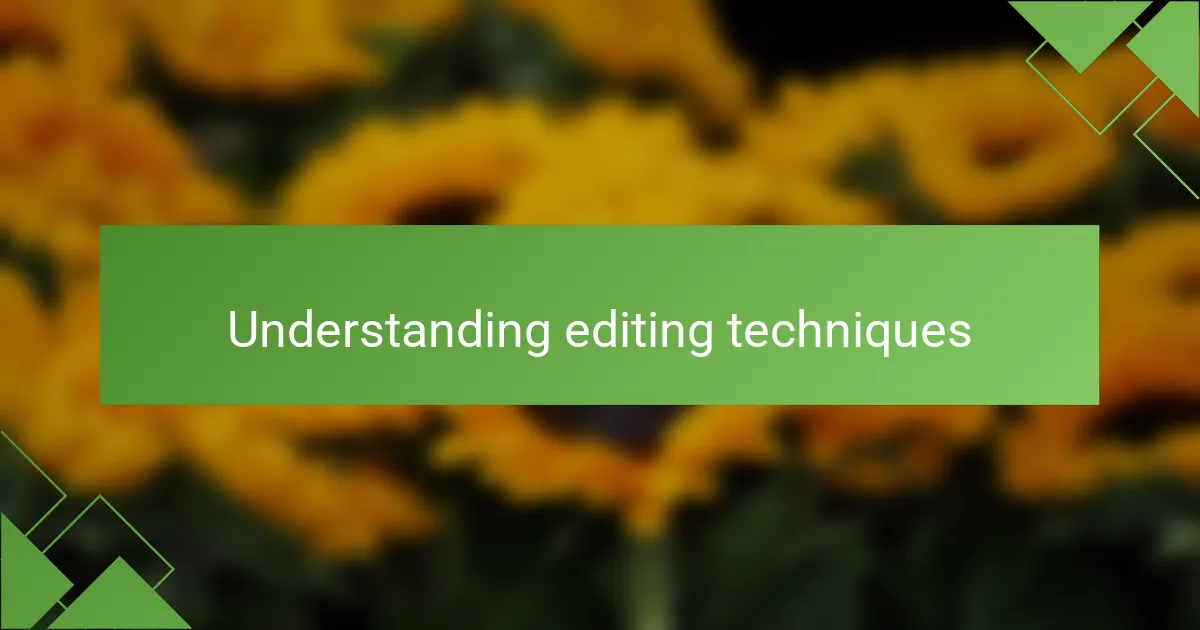
Understanding editing techniques
Editing techniques are the backbone of transforming a raw image into a compelling story. I’ve often found myself captivated by the subtle changes that can shift a photograph’s emotional impact. For instance, adjusting the contrast can evoke a completely different mood—don’t you think it’s fascinating how a small tweak can breathe life into an image?
In my experience, understanding the importance of color grading has been a game changer. A well-executed color palette can enhance the story behind the photo and resonate with viewers on a deeper level. I remember a particular project where shifting the hues brought out the vibrancy of a bustling Strasbourg market; it was as if the image truly came alive.
One technique I’ve grown fond of is the use of cropping to strengthen composition. Often, what we leave out can be just as powerful as what we include. Have you ever looked at a photograph and thought, “If only the distractions were removed?” That’s where thoughtful cropping comes into play, focusing the viewer’s attention and amplifying the subject’s significance.
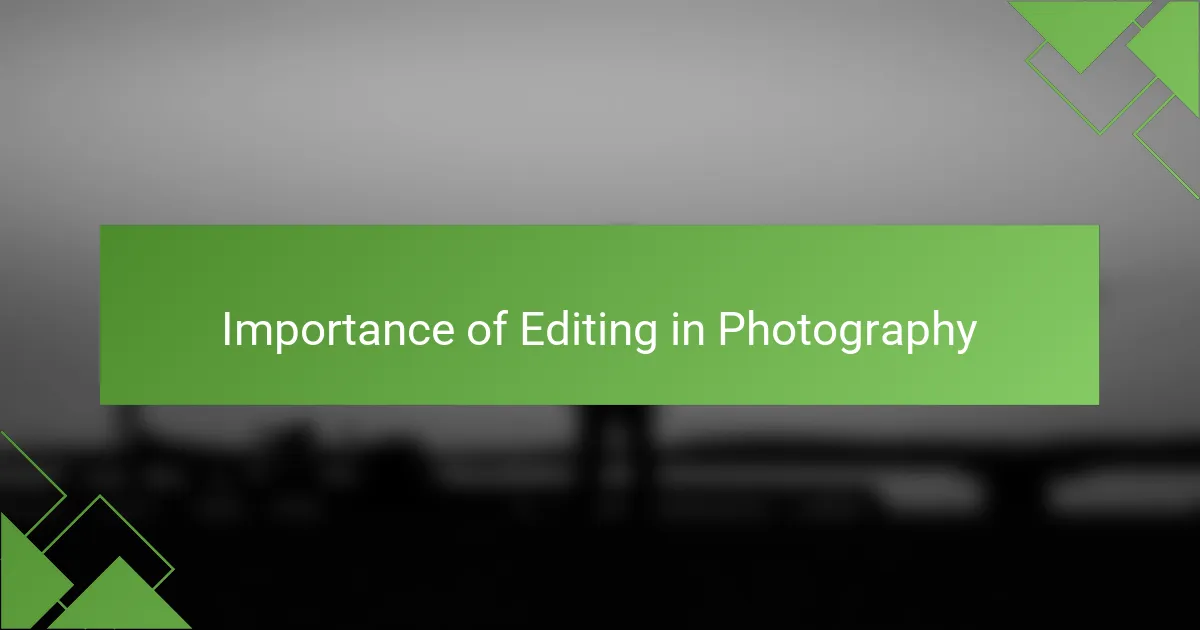
Importance of editing in photography
Editing in photography holds significant importance, as it can truly transform a moment into a masterpiece. I often think about how the right adjustments can highlight the essence of a scene, turning an ordinary photograph into something extraordinary. For example, I once edited a shot of the Strasbourg Cathedral at sunset. By tweaking the shadows and highlights, the cathedral seemed to glow, capturing the awe I felt while witnessing that moment.
Moreover, editing allows us to communicate our creative vision. I’ve realized that every adjustment I make tells a part of the story I want to share. When I enhanced the clarity and saturation of a photograph taken in the Petite France district, the vibrant colors almost leaped off the screen, making it inviting and lively. It’s rewarding to see viewers connect with the energy I felt while capturing that shot.
Furthermore, I believe that editing can be a form of personal expression. It’s like having a conversation with the image, asking, “What do you want to say?” During one of my projects, playing with different presets and filters was not just about aesthetics; it became a journey of self-discovery, revealing my unique style and perspective. Every edit holds a piece of my artistic identity, don’t you think?
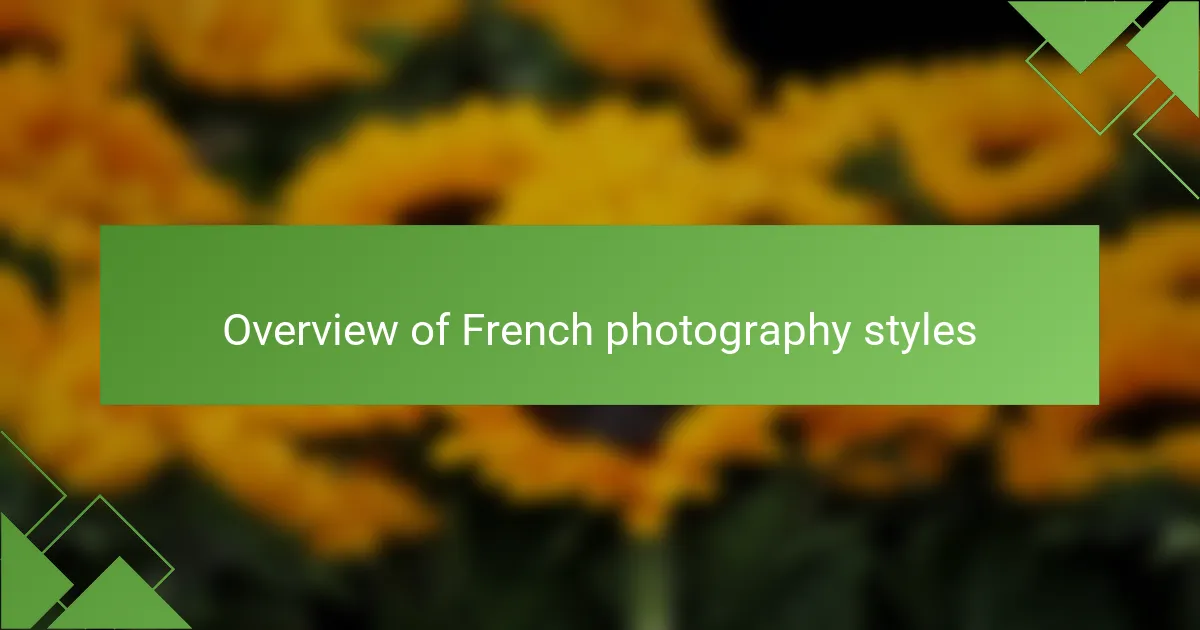
Overview of French photography styles
French photography encompasses a rich tapestry of styles that reflect its diverse culture and artistic heritage. From the chiaroscuro brilliance of classic portraiture to the vibrant colors of contemporary street photography, there’s something for every visual storyteller. I find it particularly interesting how each style carries its own history—take documentary photography, for example, which captures raw, authentic moments that resonate deeply with viewers.
I also love the allure of French fashion photography, which often tells a narrative through elegant composition and striking aesthetics. I remember leafing through iconic fashion magazines and marveling at how each image seemed to blend artistry with commerce. It’s fascinating how the photographers manage to create alluring fantasies that transcend the mere clothing on display, inviting us into a world of style and innovation.
What strikes me most is the interplay of light and shadow across various French styles. I often experiment with lighting in my own photography, inspired by the works of greats like Henri Cartier-Bresson. His decisive moments often leave me in awe and challenge me to capture that same intimacy in my street photographs. Have you ever found yourself completely immersed in the play of light? It’s this magic that ties together the various French photography styles, each inviting a unique interpretation and emotional connection.
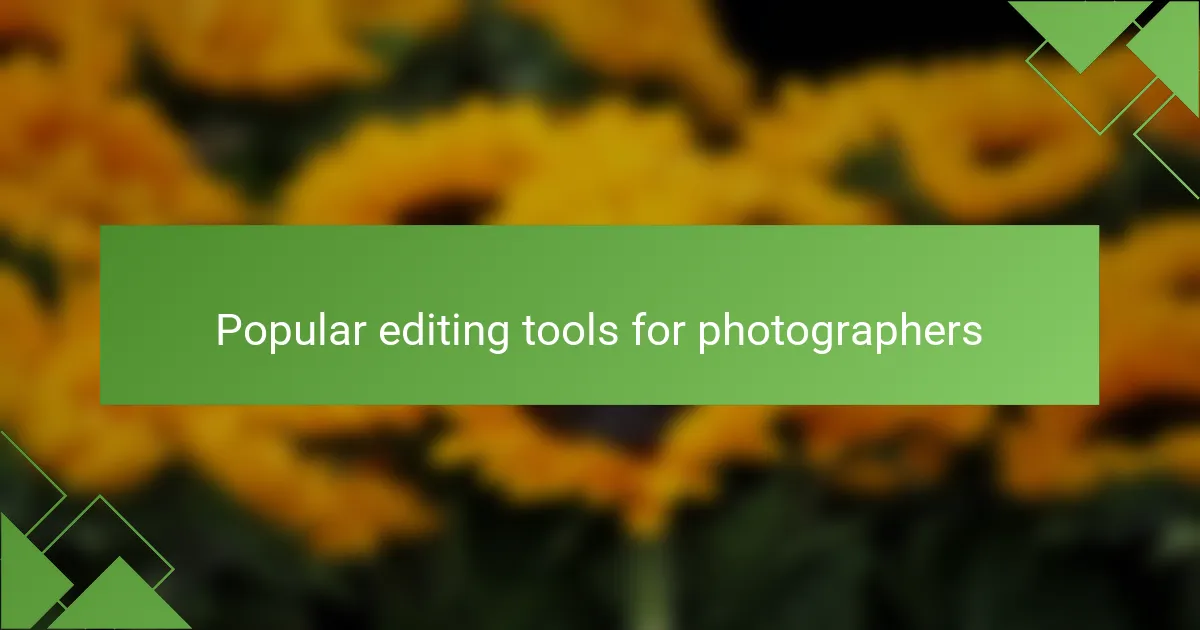
Popular editing tools for photographers
When it comes to editing tools for photographers, I’ve found that the right options can transform a good photo into a stunning visual story. Software like Adobe Lightroom has always been a favorite of mine because of its user-friendly interface and powerful processing capabilities. I still remember the first time I used it to adjust the lighting on a landscape shot in Strasbourg; it was like bringing the image to life.
Another tool that deserves mention is Photoshop, renowned for its extensive editing features, which allow for deeper manipulation. There’s something truly satisfying about using Photoshop’s layer options to remove distractions from a composition, especially when you can refine an image to near perfection. Reflecting on my own editing experiences, these tools have not only enhanced my skills but have also deepened my connection with photography.
| Editing Tool | Key Features |
|---|---|
| Adobe Lightroom | User-friendly, great for batch processing, excellent for color correction |
| Adobe Photoshop | Advanced editing capabilities, layer management, detailed retouching options |
| Capture One | Powerful RAW processing, tethering options, customizable workspace |
| GIMP | Open-source, robust editing features, free to use |
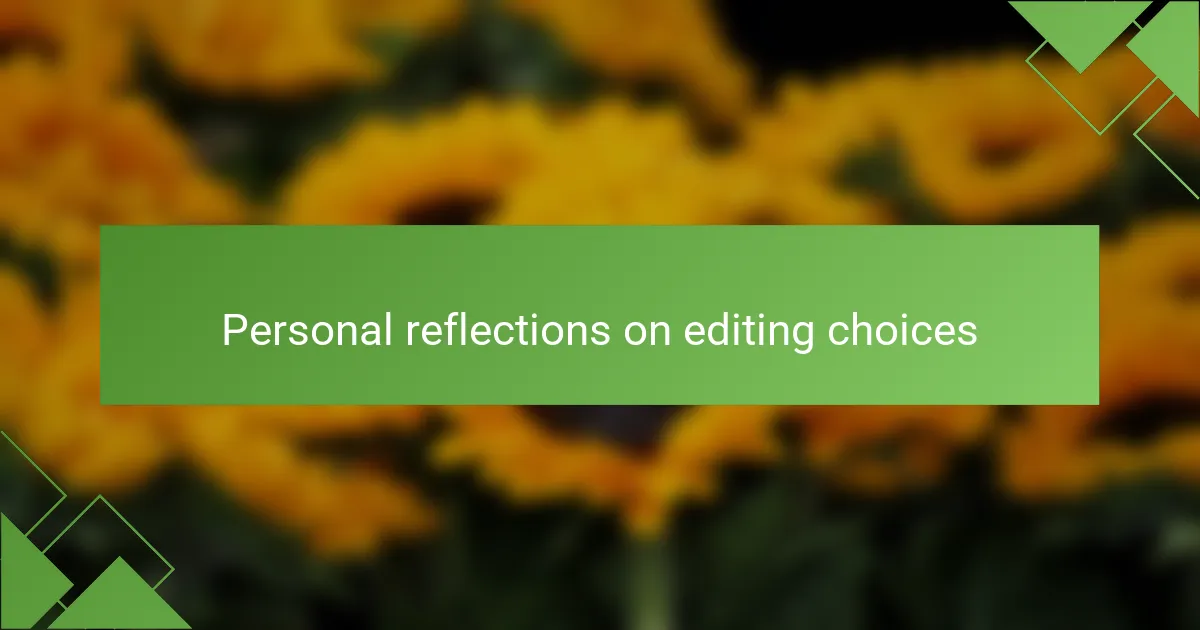
Personal reflections on editing choices
Editing choices are pivotal in photography, especially in a visually rich environment like Strasbourg. I often find myself drawn to the soft pastel colors of the city’s historic architecture. These hues inspire me to choose a warmer color palette during editing, evoking the feelings I associate with strolls along the canals.
In my experience, I lean towards subtly enhancing details rather than over-processing images. This choice reflects my belief that a photograph should retain its authenticity while still captivating the viewer. I recall one particular shot of the Strasbourg Cathedral at sunset, where I opted to accentuate the sky’s natural gradient. The result was striking; it captured not just the architecture but also the emotion of that moment.
| Editing Technique | Emotional Impact |
|---|---|
| Color Grading | Evokes warmth and nostalgia |
| Contrast Adjustment | Enhances depth and drama |
| Saturation Increase | Boosts vibrancy and energy |
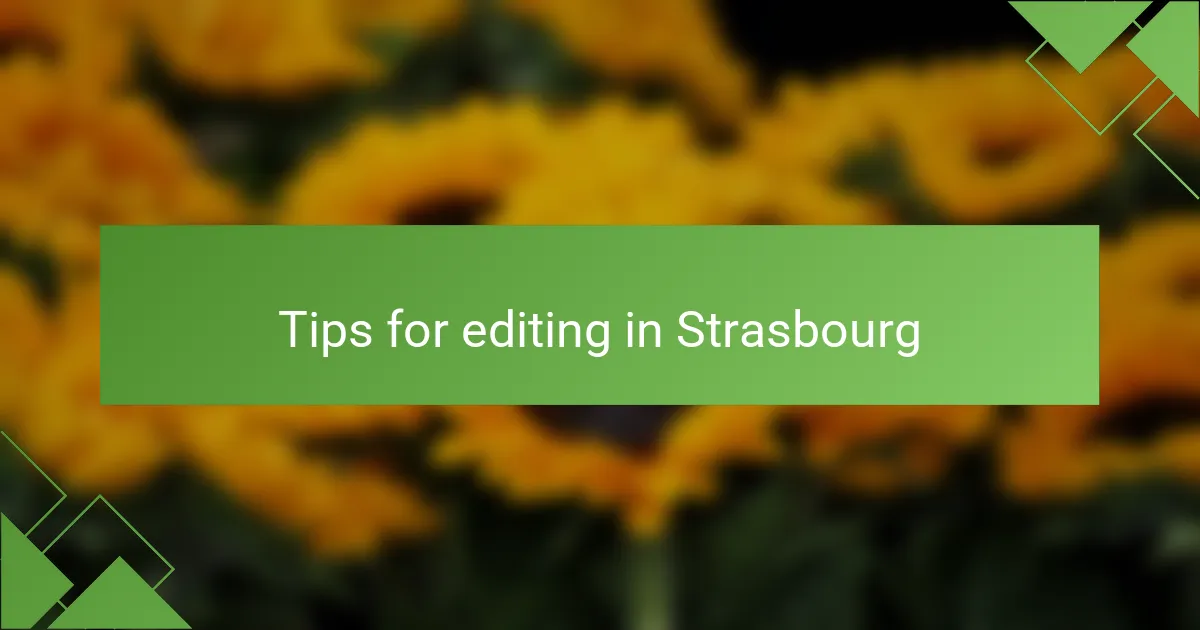
Tips for editing in Strasbourg
Editing in Strasbourg presents unique opportunities to enhance the rich visual storytelling that this beautiful city offers. One of my favorite techniques is utilizing the natural light found during golden hour. I remember capturing a shot of the Petite France district as the sun dipped low, casting a warm, golden glow over the cobblestone streets. The right adjustments in post-processing made that light even more enchanting, inviting viewers to step into that serene moment.
When editing, I also recommend paying attention to local color palettes. Strasbourg’s vibrant architecture offers a feast for the eyes—why not let those colors shine in your edits? I’ve often embraced the subtle blues and warm earth tones that characterize the city, resulting in images that feel both inviting and authentic. It’s amazing how a simple color enhancement can evoke emotions tied to that specific locale, don’t you think?
Lastly, consider incorporating textures to add depth to your images. I’ve found that applying a soft texture to a photograph taken on the grand platforms of the Cathedral can create a completely distinct atmosphere. This technique allows the viewer to feel the history and craftsmanship of the surroundings, making the experience of the image far more immersive. Have you ever explored the emotional resonance that textures can bring to your photography? It truly elevates the story being told.